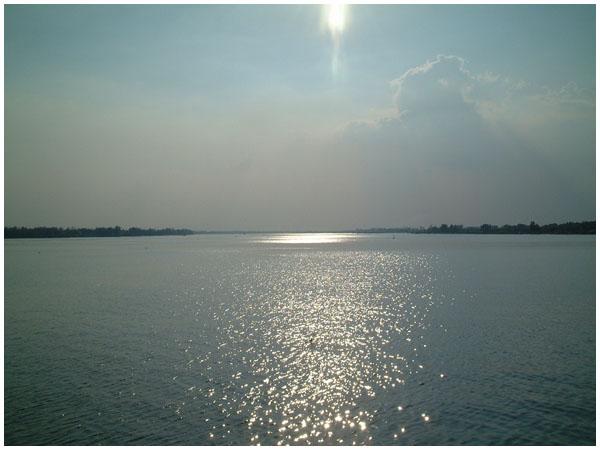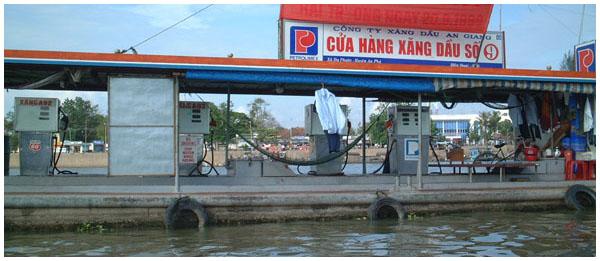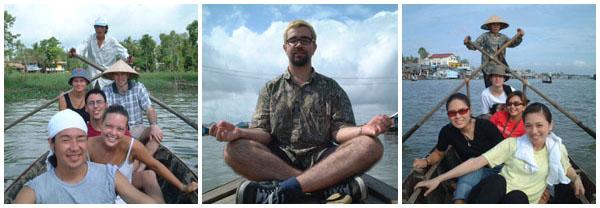riverman blues
2001.04.02, hanoi, vietnam
continuing with my plan to visit vietnam was an excellent decision. I have had a wonderful time here. directly off the plane I met some people from japan (though stuart, being canadian, doesn't quite look the part). we shared a cab into town, had dinner together, and decided to all sign up for the same mekong river tour later in the week. it is amazing how much having people to spend time with can influence your feelings about a place.
the following day, stuart and I rented motorbikes and went to visit the war museum. later that night our US$5 rental increased to US$25, as the police nicked us for going the wrong way on a one way street. not that you could tell by the traffic, nor did I actually see a sign. the ticket could be paid on the spot in cash, of course.

the museum is housed in the former US army operations center, and is a mostly photographic history of the war. I had heard that it is sometimes difficult for americans to take, but my attitude had been that I was only four years old when the war ended. it was not my war. it hardly seems to have been the war of the those who fought in it, even.
however, the museum did affect me, badly. I can not see how it would not affect anyone, regardless of citizenship. overall the coverage of the war was even-handed: many of the pictures are patriotic, but by no mean most. the largest source of photos was the western/japanese war journalists, as the revolutionary army did not have much in the way of supplies. and there is a lot of coverage of the anti-war movement in the US.

the part of the exhibit which made me sick, physically, was the extensive coverage of the use of dioxin: agent orange. this is one of the most toxic chemicals known, and was used to burn away rainforests and crops in an effort to flush out revolutionary guerillas and 'entice' farmers to move to cities where the population could be more easily controlled. it caused extreme chemical burns and (eventually) cancer in those it did not kill, and entered the water supply in massive amounts.

saigon is full of people my age and younger who are the fruit of the agent orange harvest. the lucky ones are missing most digits or have limbs of differing lengths. (perhaps the luckiest are the fetuses which never leave the hospital.) some have limbs and faces so twisted they are terrible to look at, more terrible because as an american I do indeed feel responsible. I hate my country for doing this.
one thing that is remarkably absent in ho chi minh city is the presence of beggars. there are many people selling food, books, lighters, maps, cyclo rides; but no one asked me for money. there are a lot of children working, either selling or at more adult trades. I never saw one person who really looked hungry, and most people seem relatively happy. I say relatively because the presence of so many western tourists obviously shows them many things that they do not have. I am not trying to argue that these people have great lives, that they should seek no more; but to some degree ignorance is bliss, and the slight distance between rich and poor in vietnam is admirable.
2001.04.03
the absolute highlight of my time in south vietnam was a three day mekong delta tour. it was a pretty big group, a great mix of young people and some slightly older couples. the bus rides were sometimes long, but much of the travel time was instead spent on boats travelling around a few of the many thousands of natural and man-made canals which crisscross the broad plain.

on the first day of our tour, we took a trip through some very narrow canals in a densely forested area. this was the 'operations center' and home of the leaders of the viet cong, and has been set aside as a museum and nature preserve. it was here that people learned how to make bamboo spikes and other natural weapons, and organized the resistance against the US and south vietnamese armies. the houses are similar to those we saw people living in later in the tour, albeit more remote: a far cry from the US army operations center in the middle of saigon.

that evening we crossed one of the two major arms of the mekong, probably about 1.5 kilometers across. as of today, there is only one bridge across either of these channels which cut off a huge triangle of the region: that bridge opened only last year. all other transport is by boat, either human or gas powered.

the following morning, we left early for another boat tour, this time on a much larger stretch of river. many of these people are an ethnic minority, largely muslim, who migrate on the river between cambodia and vietnam. here, the wealthier families live in floating houses which serve as protection against tides and floods, and allow the family to raise tens of thousands of fish in an enclosed area beneath. our guide explained the economics of the trade in some detail, as though trying to convince us to buy a river house (US$6-20k) and set up shop. I hate fish, though, and don't think I could deal with the fumes from the neighboring floating pig farms.

everywhere we stopped, we were surrounded by children wanting pens and chewing gum. while it might seem fun or fulfilling to hand out such tidbits, it is a bit like pouring blood in shark-infested waters. invariably, there is a bully who gets quite a lot and some who get pushed to the sides and get none: survival of the fittest played out in a mini parody of lord of the flies. one exception to this was the following day at a heron sanctuary where all the kids paired off with exactly one adult, holding the adults' hands and making for us intricate little baskets and jewelry from palm and banana leaves. in exchange, we were expected to buy them coke or gum when we all got back to the bus. one wonders who organized this arrangement: the kids or the store owners? in any case, it was much less daunting than the free-for-all we might otherwise have faced.

on the last day of the tour, we attempted to visit a floating market; but the tides were against us and it was breaking up by the time we got there. the mekong region is enormous, but is almost all influenced by the tides as well as by seasonal flooding. the farmers in the area count on the rains to carry away the salt that gets brought in from by the tides. we spent a couple of hours at a very local non-floating market (duck fetuses anyone? pig liver?) before beginning the long trek back to saigon. most of this trip was spent on a large boat, heading out to the main river. the weather was beautiful, the boat created a pleasant breeze, children would call out and wave at every house we passed: it was a heavenly end to an excellent tour.

the night we came back, I was exhausted. I had not slept very well on the tour at all: the 6 am wake-up times conflicted with my natural rhythm of 10 or noon. I took a short nap, but then chose to join everyone else for dinner and drinks: bad idea. I stayed up late, got drunk, and fell asleep in a chair on the balcony of the dorm room in which I was staying. I was very dehydrated when I switched hotels to have a private room: by the time I woke up that evening there was something seriously wrong in my gut.

I was really out of it for a couple of days. I think I forgot to eat for a while there--it was all I could do to get enough water into my body--and when I did remember all I could get down without feeling immediately sick was white rice and bananas. while I was slightly feverish at first, that went away once I started drinking lots of water; and it never really touched my stomach. rather, it felt like an invisible giant would occasionally take hold of my guts and squeeze everything out of them.
I considered taking some over-the-counter antibiotics (everything is over-the-counter here--except for marijuana, opium, and heroin which can be had just down the street), but tour-mate-and-doctor petra convinced me that my body would sort it all out if I gave it some time and rest. I am still sick, actually, though I am up to two meals a day and so I have a lot more energy. at this point, it just isn't affecting me too much.
given a couple day delay for recovery, I decided to buy an airplane ticket directly from ho chi minh city to hanoi. I had really wanted to visit hoian and hue, and spend some time on the beach, but I dreaded the thought of almost 40 hours on a bus to end up in hanoi in time for my return to bangkok.

before leaving, I did manage to get to the reunification palace. this was the former presidential palace of south vietnam. it was the primary target when the combined north vietnamese and viet cong armies took saigon in 1975, and I think it is from here that the last few families were airlifted on that day. it has been maintained in that state ever since, and shows the influence of 1960s american design and architecture: a penchant for orange, simple geometrical shapes.
it was very interesting to walk around and see the various audience rooms, visiting diplomat chambers, offices, the war room. the maps in the war room, in particular, remind one that vietnam was for a while two very separate countries. I wonder if the war could've ended differently, or at least if there could've been another chain of events that might have avoided the war and resulted in a still-separate south vietnam. I met a lot of war veterans who had fought on the south-vietnamese side and/or had been trained by the american army. while they are definitely happy the war is over and wish to keep it in the past, they are disgusted by the poverty of their country. I get the impression that things were much better back in the 60s, at least for some.
